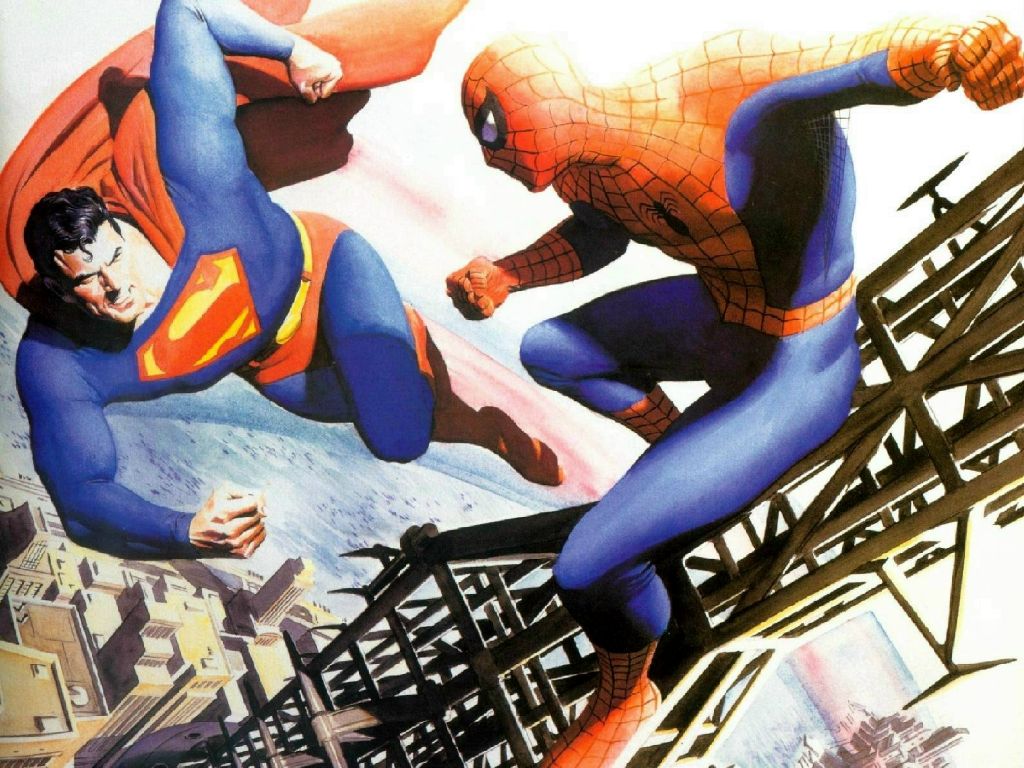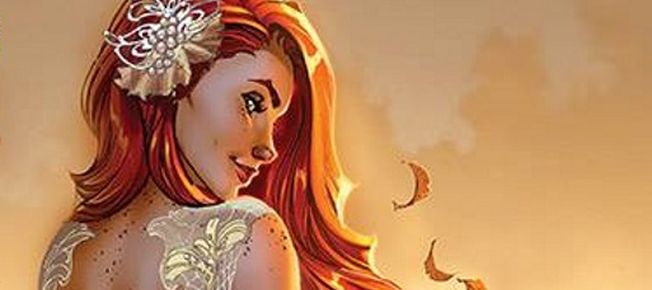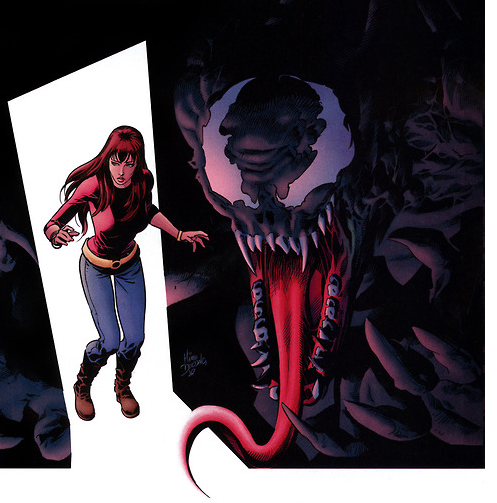 Spider-Man’s the flagship character for the Marvel Universe, so it might be interesting to compare the differences with the distinguished competition. What attributes of the Spider-Man comics are the result of being published by Marvel, and what would he be like if he were a DC character?
Spider-Man’s the flagship character for the Marvel Universe, so it might be interesting to compare the differences with the distinguished competition. What attributes of the Spider-Man comics are the result of being published by Marvel, and what would he be like if he were a DC character?
I’ve noticed some similarities in the approaches of the two publishers, along with the structural differences. There’s the obvious caveat that these statements aren’t universal. Marvel has borrowed from DC, and DC has borrowed from Marvel. There are numerous writers with acclaimed runs for both companies, which means that they bring their approaches to the two universes. Peter David’s Marvel work is well-known, but he also did 80 issues of SUPERGIRL and 50+ issues of AQUAMAN. Mark Waid started at DC, but he’s been at Marvel for some time. SPIDER-MAN/ DEADPOOL writer Joe Kelly was on ACTION COMICS for a few years, while artist Ed McGuinness drew a few Superman titles.
The companies feature something rare in pop culture: shared universes with decades of backstory. The main difference between Marvel and DC seems to be three guys who worked together: Stan Lee, Jack Kirby and Steve Ditko. The majority of Marvel’s great characters were created during a ten year period in which Stan Lee was the lead writer and Editor in Chief of the company, with Kirby and Ditko as his top artists. While a few top Marvel characters were created before and since (Captain America, Wolverine, the new X-Men, the Punisher), there was no period at DC that was comparatively influential. The unified foundation was part of Marvel since its inception. Two of the company’s most popular Golden Age characters: the Human Torch and Namor, first appeared in the same issue of the anthology title MARVEL COMICS.
Meanwhile, DC has actually absorbed various superhero universes. The incorporation of Wildstorm into the patchwork quilt was one of the more recent and prominent. Plastic Man was the top superhero of the Quality Comics line. Captain Atom and Blue Beetle were Charleton Comics headliners. And once upon a time, DC was so worried about the Shazam! Captain Marvel that they sued publisher Fawcett Comics for copyright infringement. This was ingrained into the company from the start, as the publisher had many talents on their payroll contributing to their roster of superheroes and supervillains on several different titles. Bob Kane and Bill Finger created Batman in DETECTIVE COMICS, though Jerry Robinson was probably responsible for the Joker in the first issue of BATMAN. Another duo Joe Shuster and Jerry Siegel created Superman in ACTION COMICS. William Moulton Marston and Harry G. Peter made Wonder Woman, while the Flash was invented by Gardner Scott and Harry Lampert.

It’s telling that during the Silver Age, different editors were responsible for reviving DC’s top heroes: Mort Weisinger with Superman, and Julius Schwartz with Batman. The era was also marked by new versions of Green Lantern and the Flash, which created a conundrum as Superman and Batman had some adventures with the Golden Age versions. The result was the revelation that there was two DC Universes—Earth-1 and Earth-2—although the number would soon expand. A few other talents also made major contributions to DC franchises during this period, including Marvel ex-pats. Steve Ditko created the Creeper and Shade the Changing Man, while Jack Kirby created Darkseid, Mister Miracle, OMAC and the New Gods.
Grant Morrison summed it up in Supergods.
And now there were two healthy universes living and growing inside our own. The DC Universe was a series of islands separated for years, suddenly discovering one another and setting up new trade routes. And there was Marvel’s beautifully orchestrated growth and development.
Marvel is defined by one brilliant decade-long burst of creativity, while DC is defined by its ability to incorporate once standalone franchises. If Stan Lee had been hit by a bus in 1959, it’s entirely possible that DC would now own what was left of Marvel.
The source of the most acclaimed stories is another major difference between the latest subsidiary of the House of Mouse and its Distinguished Competition. The majority of the best DC comics are self-contained, often separate from the main continuity. Examples would be DARK KNIGHT RETURNS, ALL-STAR SUPERMAN, KINGDOM COME and NEW FRONTIER. There are also numerous Vertigo titles, usually in their own world separate from any other book. Many projects which are technically part of the shared universe are still rather solitary, like BATMAN: YEAR ONE or the Killing Joke. It seems entirely appropriate that a Batman anthology title continued for over 200 issues. You could look at IGN’s list of the best Batman collections to see how few of their favorite stories are part of the character’s “present” and not flashbacks, or reimaginings outside of the standard DC Universe.
At the same time, the majority of the best Marvel comics are clearly in-continuity, including 23 out of 25 of IGN’s 25 favorite Spider-Man stories. The most acclaimed Marvel Stories (IE- Daredevil: Born Again, The Night Gwen Stacy Died, the Dark Phoenix Saga) are usually part of an ongoing title, building on the work of earlier creative teams and setting up items for the next guys. The self-contained projects are still set in a specific time period, tying to prior continuity. Examples would be MARVELS, DAREDEVIL: YELLOW or the first four issues of SPIDER-MAN/ HUMAN TORCH: I’m WITH STUPID. Even with the exceptions, there’s still a clear foundation. The Ultimate books were simply a second shared universe for Marvel, and the same rules applied. A few of Mark Millar’s standalone projects: the mini-series 1985 and the future Wolverine saga Old Man Logan, featured characters who reappeared in his FANTASTIC FOUR run with Bryan Hitch. EARTH X, Marvel’s answer to KINGDOM COME, was part of a 50+ issue epic, which still built on the history of the characters. Hickman’s SECRET WARS did feature a lot of self-contained mini-series, and there are now a few monthly titles set in their own worlds (SPIDER-GWEN comes to mind) but these are usually spinoffs of events in monthly titles.

Because Marvel stories weren’t standalone, subplots often matter. The characters could find themselves in a different place at the end of the story than at the beginning, and that could affect where they are in the next issue. This may be why Spider-Man’s satellite titles have struggled, while Batman and Superman have plenty. It usually didn’t matter if a particular story occurred in ACTION COMICS or SUPERMAN, since there was very little issue to issue continuity. Ongoing subplots in the Spider-Man books made it tougher to balance multiple titles. MARVEL TEAM-UP, the first attempt, focused mostly on the superhero side of things, with very little development on Peter Parker’s life to affect things in AMAZING SPIDER-MAN.
There are also larger changes for the characters at Marvel. There are multiple iterations of the X-Men, and using a particular team in a flashback story (IE- The original five, The international new X-Men) results in a different dynamic. Spider-Man started out as a kid in high school, but then he went to college, graduated college, and went on to hold several jobs for different companies. At DC, Bruce Wayne is typically a playboy billionaire who hangs out with Alfred and Commissioner Gordon. The main thing that changes from year to year would be which Robin he takes on patrol. Clark Kent is usually a newspaper reporter, working with Perry White, Jimmy Olson and Lois Lane. The main differences between the status quos are the result of universe-wide retcons (IE- Are his parents alive?) rather than ongoing developments in the comics.
In the Emmys, DC would be the company that racks up wins in the Mini-Series and TV Movie categories. Marvel would usually win for TV series and Individual Episodes. And if Marvel wins in the “DC categories” it’s because of something set in a specific period of the character’s history, either an untold tale or a deliberate retelling. There are some exceptions. And I might be coming at this from an unenlightened perspective, as someone more familiar with the better-known and more accessible (and therefore less interconnected) DC projects.
But this does build on the idea that the major difference between the two companies is that DC is a patchwork universe, while Marvel is built on a solid foundation. Continuity has been altered so often in the DC Universe that there isn’t really a clear backstory for the characters. So there are incentives to just go with what’s iconic about the characters, and build from there, for the sake of a story. And with their trade program, there’s a bias towards more accessible work.
With Marvel, there’s a mostly consistent continuity, with a few patches. Their trade program is geared towards introducing readers to extensive runs on titles (Bendis’s Ultimate Spider-Man, Hickman’s Avengers, Frank Miller’s Daredevil, anything Stan Lee wrote, etc.) And anything set in the past is set in a specific period of a character’s history, as a story set between AMAZING SPIDER-MAN #33 and #34 is going to be different than one set between #30 and #31. Not to gloat, but a key difference could just be that Marvel’s old stories hold up better, so writers feel comfortable explicitly referencing the stuff.
Are there other major differences between Marvel and DC? And has that there been an impact on the Spider-Man comics? Let me know in the comments below.

More Marvel Examples: Amazing Spider-Man #31-33 (the Master Planner Saga). Amazing Spider-Man #229-230 (Nothing Can Stop the Juggernaut). Fantastic Four #48-50 (the Galactus saga). Fantastic Four #51 (This Man, This Monster). Fantastic Four #258 (the Day in the Life of Doctor Doom). Fantastic Four #267 (“A Small Loss”). Uncanny X-Men #125-128 (the Search for Mutant X). Uncanny X-Men #141-142 (the Days of Future Past). Daredevil #168-181 (the Elektra Saga). Iron Man #120-128 (the alcoholism story). Incredible Hulk: Future Imperfect. The Ultimates. Captain America: The Winter Soldier.
More DC Examples: Golden Age. Watchmen. Superman: Secret Identity. Arkham Asylum (either the Grant Morrison/ Dave McKean graphic novel or the Dan Slott/ Rick Burchett mini-series.) Brian Azzarello and Lee Bermejo’s Joker. Superman For All Seasons. Camelot 3000. Pretty much every Elseworlds project. The Paul Dini/ Alex Ross one-shots. Batman: Black and White.
More Marvel Exceptions: Unstable Molecules. Silver Surfer: Requiem. Startling Stories: Banner. Starting Stories: Thing- It All Started on Yancy Street. Punisher: MAX.
More DC Exceptions: Alan Moore’s Swamp Thing. Crisis of Infinite Earths. James Robinson’s Starman. Geoff Johns’s JSA. Geoff Johns’s Green Lantern. Marv Wolfman and George Perez’s Teen Titans. Mark Waid’s Flash. Gotham Central. Neil Gaiman’s Sandman. 52. John Byrne’s Superman. The current Superman titles.
Partial List of Marvel characters co-created by Stan Lee, Jack Kirby and/ or Steve Ditko: Peter Parker/ Spider-Man, J. Jonah Jameson, Flash Thompson, Norman Osborn/ the Green Goblin, Mary Jane Watson, Harry Osborn, May Parker, Sandman, Curt Connors/ the Lizard, the Fantastic Four, Captain America, the Black Panther, the Silver Surfer, the Inhumans, Nick Fury, Doctor Doom, the X-Men, the Sentinels, Magneto, the Avengers, Tony Stark/ Iron Man, Bruce Banner/ the Hulk, the Leader, the Abomination, Daredevil, Scarlet Witch, Quicksilver, Willie Lumpkin.









I really don’t agree with the assessment that DC’s best stuff is standalone. Knightfall, Hush, Death of Superman, No Man’s Land, etc are all very continuity driven.
Furthermore in the mid-1980s DC adopted a continuity more akin to Marvel’s and consequently reconciling the placement of ssatellite stories in relation to one another did matter, hence the Superman books’ triangle numbering system.
As for Spider-Man’s satellites struggling, MTU lasted 150+ issues, Spec was over 260, even Web of Spider-Man wasn’t too far off 150 issues.
As for other differences, I think wen you take into account what was happening in the 1960s you can clearly see that DC’s characters were powers first and people second, whereas the reverse was true for Marvel. This consequently has led to DC having more legacies.
In a sense it’s more acceptable for there to have been 3 or more Flashes and Green lanterns by the 1990s because the idea behind those characters both stemmed first from their powers and emphasis was placed squarely upon those. Flash is a guy who runs fast. As such it wasn’t as important who was wearing that costume.
In contrast Spider-Man and the Fantastic Four were defiend as people and personalties ahead of their abilities. Those powers mattered, but at most they weren’t the point.
The Flash is the fast guy, and you have three options for that. With Spider-Man, he IS Peter Parker, not anyone who happens to wear webbed spandex. Change the man beneath the mask and you might have someone interesting but it will not be Spider-Man.
When I was growing up in my youth years for me it was a toss up between Marvel and DC. When I was in my mid teenager years it became soulful Marvel and Spider-Man was always my number one hero with the incredible hulk as my second favorite, I had met Todd McFarlane twice while he was working on The Amazing Spider-Man and on the adjacent less Spider-Man titles. I really am one that loved the Spider-Marriage for more reasons I can talk about here. I have only picked up maybe since O.M.D. a total two trades and 600 and the red headed Stranger arc of the early 600’s and the last 12 before ock was Spider-Man with the nickname reference to a certain Vulcan of Star Trek frame. Now it’s really a toss up of D.C.Comics or indie comics for me mostly. Don’t get me wrong I still love Spider-man and his alternative self Peter Parker but till Marvel can put out a Married Spider-Man book and yes it has to be to Mary Jane they will only get my money on the current Spider-Man /Deadpool series!